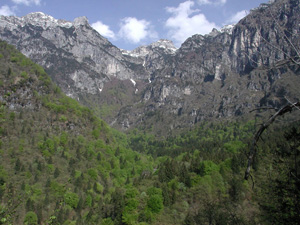| Card n. | Description | Locality | Linked sites |
| 71 | San Martino Valley | Feltre | 159 |
| file .pdf | Naturalistic Interest Sites (SIN) | Google maps |
 |
 |
 |
- Description
- How to get there
- Interesting facts
- Bibliography
The now solitary San Martino valley was once an important transport route for activities connected to the mountains and woodlands, such as stock raising, lime production and the transport of ice. The landscape is characterised mostly by glacial valleys such as the Scalon, which come down from the Vette Feltrine peaks, the huge stone boulders deposited at the end of the ice ages (at Pian dei Violini) and the fine series of erosion potholes on the upper stretch of the Stien torrent. The waters of the rushing torrent and its small affluents, fed by Karst springs, drain part of the streams that filter down into the plateau of the Vette Feltrine. Apart from the explanatory panels put in place by the Dolomiti Bellunesi National Park, the only signs here of Man’s presence are a characteristic little church with a two-pitch roof and a large, well preserved calchera that was once used to produce lime and fire stones. Running through the valley is one of the themed routes mapped out by the Park, which links up a number of little piedmont churches; near Vignui, in a strategic position, is the church dedicated to San Martino, mentioned in documents from 1584, but very probably dating back even further.
The San Martino valley can be easily reached from Feltre along the provincial piedmont road that runs towards Cesiomaggiore. Just after Foèn, on the left, follow the signs for Vignui.
ACCESSIBLE: yes
MUNICIPALITY: Feltre
PLACE: San Martino
GEOGRAPHICAL COORDINATES: X 1724714 -Y 5105984
PROVINCE: Belluno
FILE COMPILED BY: Visentin
Right at the point where the Stien torrent meets the Caorame, on the left of the Stien, is Villa Lusa, built over a mediaeval tower and thus referred to as Lusa Castle. Once a feudal residence and part of the defence system of the Bishops of Feltre and Belluno, the Villa today houses the Accademia del Melograno historical institute
M. Cassol, D. Dal Zotto, Le vie dell’acqua. Alla scoperta di un territorio. Prealpi Bellunesi e Trevigiane, Belluno, 2007
Various Authors, Il Piave, Verona, 2000
L. Bortolos, T. Conte, Chiesette pedemontane. Santi guerrieri e Santi guaritori nelle Dolomiti Bellunesi, Verona, 1999

